Energy Harvesting for Wearable Sensors and Body Area Network Nodes
Abstract
1. Introduction
2. The Human Body as an Energy Generator
- Low-intensity activity < 3 MET;
- Medium-intensity activity (3–6) MET;
- High-intensity activity > 6 MET.
3. Kinetic- and Thermal-Energy-Harvesting Technique Dedicated to BAN
3.1. Electromagnetic Energy Harvester
3.2. Piezoelectric Harvesters
3.3. Triboelectric Harvesters
3.4. Thermogenerators
4. Energy Harvesters Using the Power of Electromagnetic Waves
4.1. Rectenna for Wearable Applications
Textile-Based Rectenna
4.2. Photovoltaic Energy Harvesting for Wearables and Body Area Network
5. Conclusions
Author Contributions
Funding
Institutional Review Board Statement
Informed Consent Statement
Data Availability Statement
Conflicts of Interest
References
- Tesla, N. Experiments with alternate currents of high potential and high frequency. J. Inst. Electr. Eng. 1892, 21, 51–162. [Google Scholar] [CrossRef]
- Aabid, A.; Raheman, M.A.; Ibrahim, Y.E.; Anjum, A.; Hrairi, M.; Parveez, B.; Parveen, N.; Zayan, J.M. A Systematic Review of Piezoelectric Materials and Energy Harvesters for Industrial Applications. Sensors 2021, 21, 4145. [Google Scholar] [CrossRef] [PubMed]
- Ando Junior, O.H.; Maran, A.L.O.; Henao, N.C. A Review of the Development and Applications of Thermoelectric Microgenerators for Energy Harvesting. Renew. Sustain. Energy Rev. 2018, 91, 376–393. [Google Scholar] [CrossRef]
- Kanoun, O.; Khriji, S.; Naifar, S.; Bradai, S.; Bouattour, G.; Bouhamed, A.; El Houssaini, D.; Viehweger, C. Prospects of Wireless Energy-Aware Sensors for Smart Factories in the Industry 4.0 Era. Electronics 2021, 10, 2929. [Google Scholar] [CrossRef]
- Wang, H.; Jasim, A.; Chen, X. Energy Harvesting Technologies in Roadway and Bridge for Different Applications—A Comprehensive Review. Appl. Energy 2018, 212, 1083–1094. [Google Scholar] [CrossRef]
- Park, G.; Rosing, T.; Todd, M.D.; Farrar, C.R.; Hodgkiss, W. Energy Harvesting for Structural Health Monitoring Sensor Networks. J. Infrastruct. Syst. 2008, 14, 64–79. [Google Scholar] [CrossRef]
- Zou, Y.; Sun, M.; Xu, W.; Zhao, X.; Du, T.; Sun, P.; Xu, M. Advances in Marine Self-Powered Vibration Sensor Based on Triboelectric Nanogenerator. J. Mar. Sci. Eng. 2022, 10, 1348. [Google Scholar] [CrossRef]
- Salehi, H.; Burgueño, R.; Chakrabartty, S.; Lajnef, N.; Alavi, A.H. A Comprehensive Review of Self-Powered Sensors in Civil Infrastructure: State-of-the-Art and Future Research Trends. Eng. Struct. 2021, 234, 111963. [Google Scholar] [CrossRef]
- Chen, H.; Xing, C.; Li, Y.; Wang, J.; Xu, Y. Triboelectric Nanogenerators for a Macro-Scale Blue Energy Harvesting and Self-Powered Marine Environmental Monitoring System. Sustain. Energy Fuels 2020, 4, 1063–1077. [Google Scholar] [CrossRef]
- Ganiyu, S.O.; Martínez-Huitle, C.A. The Use of Renewable Energies Driving Electrochemical Technologies for Environmental Applications. Curr. Opin. Electrochem. 2020, 22, 211–220. [Google Scholar] [CrossRef]
- Dziadak, B.; Makowski, Ł.; Michalski, A. Survey of Energy Harvesting Systems for Wireless Sensor Networks in Environmental Monitoring. Metrol. Meas. Syst. 2016, 23, 495–512. [Google Scholar]
- Mamun, M.A.A.; Yuce, M.R. Sensors and Systems for Wearable Environmental Monitoring Toward IoT-Enabled Applications: A Review. IEEE Sens. J. 2019, 19, 7771–7788. [Google Scholar] [CrossRef]
- Zhao, L.; Li, H.; Meng, J.; Li, Z. The Recent Advances in Self-Powered Medical Information Sensors. InfoMat 2020, 2, 212–234. [Google Scholar] [CrossRef]
- Zheng, Q.; Tang, Q.; Wang, Z.L.; Li, Z. Self-Powered Cardiovascular Electronic Devices and Systems. Nat. Rev. Cardiol. 2021, 18, 7–21. [Google Scholar] [CrossRef] [PubMed]
- Jiang, D.; Shi, B.; Ouyang, H.; Fan, Y.; Wang, Z.L.; Li, Z. Emerging Implantable Energy Harvesters and Self-Powered Implantable Medical Electronics. ACS Nano 2020, 14, 6436–6448. [Google Scholar] [CrossRef] [PubMed]
- Kleiber, M. Body Size and Metabolic Rate. Physiol. Rev. 1947, 27, 511–541. [Google Scholar] [CrossRef] [PubMed]
- Keler, J.S. Human Energy Balance; SGGW: Warsaw, Poland, 2017. (In Polish) [Google Scholar]
- Keller, J.S. Maintenance Energy Requirements in Adult and Growing Organisms—An Unresolved Problem. J. Anim. Feed Sci. 2002, 11, 351–366. [Google Scholar] [CrossRef]
- Włodarek, D.; Lange, E.; Kozłowska, L.; Głąbska, D. Dietoterapia 1. Zapotrzebowanie Energetyczne Organizmu Człowieka; Państwowe Zakłady Wydawnictw Lekarskich: Warsaw, Poland, 2014. [Google Scholar]
- Frappier, J.; Toupin, I.; Levy, J.J.; Aubertin-Leheudre, M.; Karelis, A.D. Energy Expenditure during Sexual Activity in Young Healthy Couples. PLoS ONE 2013, 8, e79342. [Google Scholar] [CrossRef]
- Piñuela, M.; Mitcheson, P.D.; Lucyszyn, S. Ambient RF Energy Harvesting in Urban and Semi-Urban Environments. IEEE Trans. Microw. Theory Tech. 2013, 61, 2715–2726. [Google Scholar] [CrossRef]
- Covaci, C.; Gontean, A. Piezoelectric Energy Harvesting Solutions: A Review. Sensors 2020, 20, 3512. [Google Scholar] [CrossRef]
- Caliò, R.; Rongala, U.B.; Camboni, D.; Milazzo, M.; Stefanini, C.; De Petris, G.; Oddo, C.M. Piezoelectric Energy Harvesting Solutions. Sensors 2014, 14, 4755–4790. [Google Scholar] [CrossRef] [PubMed]
- Hyland, M.; Hunter, H.; Liu, J.; Veety, E.; Vashaee, D. Wearable Thermoelectric Generators for Human Body Heat Harvesting. Appl. Energy 2016, 182, 518–524. [Google Scholar] [CrossRef]
- Song, H.; Huang, X.; Jiang, X.; Wang, J. The synchronized switch harvesting circuit on inductor based on piezoelectricity. In Proceedings of the 2011 International Conference on Consumer Electronics, Communications and Networks (CECNet), Xianning, China, 16–18 April 2011. [Google Scholar] [CrossRef]
- Lallart, M.; Richard, C.; Li, Y.; Wu, Y.; Guyomar, D. Load-Tolerant, High-Efficiency Self-Powered Energy Harvesting Scheme Using a Nonlinear Approach. Energy Harvest. Syst. 2014, 1, 197–208. [Google Scholar] [CrossRef]
- Tri Nguyen, H.; Genov, D.A.; Bardaweel, H. Vibration Energy Harvesting Using Magnetic Spring Based Nonlinear Oscillators: Design Strategies and Insights. Appl. Energy 2020, 269, 115102. [Google Scholar] [CrossRef]
- Gao, M.; Wang, Y.; Wang, Y.; Wang, P. Experimental Investigation of Non-Linear Multi-Stable Electromagnetic-Induction Energy Harvesting Mechanism by Magnetic Levitation Oscillation. Appl. Energy 2018, 220, 856–875. [Google Scholar] [CrossRef]
- Zhang, Q.; Wang, Y.; Kim, E.S. Electromagnetic Energy Harvester With Flexible Coils and Magnetic Spring for 1–10 Hz Resonance. J. Microelectromech. Syst. 2015, 24, 1193–1206. [Google Scholar] [CrossRef]
- Wu, S.; Luk, P.C.K.; Li, C.; Zhao, X.; Jiao, Z. Investigation of an Electromagnetic Wearable Resonance Kinetic Energy Harvester With Ferrofluid. IEEE Trans. Magn. 2017, 53, 4600706. [Google Scholar] [CrossRef]
- Li, C.; Wu, S.; Luk, P.C.K.; Gu, M.; Jiao, Z. Enhanced Bandwidth Nonlinear Resonance Electromagnetic Human Motion Energy Harvester Using Magnetic Springs and Ferrofluid. IEEE/ASME Trans. Mechatron. 2019, 24, 710–717. [Google Scholar] [CrossRef]
- Samad, F.A.; Karim, M.F.; Paulose, V.; Ong, L.C. A Curved Electromagnetic Energy Harvesting System for Wearable Electronics. IEEE Sens. J. 2016, 16, 1969–1974. [Google Scholar] [CrossRef]
- Mitura, A.; Kecik, K. Modeling and Energy Recovery from a System with Two Pseudo-Levitating Magnets. Bull. Pol. Acad. Sci. Tech. Sci. 2022, 70, e141721. [Google Scholar]
- Fu, H.; Theodossiades, S.; Gunn, B.; Abdallah, I.; Chatzi, E. Ultra-Low Frequency Energy Harvesting Using Bi-Stability and Rotary-Translational Motion in a Magnet-Tethered Oscillator. Nonlinear Dyn. 2020, 101, 2131–2143. [Google Scholar] [CrossRef]
- Li, M.; Deng, H.; Zhang, Y.; Li, K.; Huang, S.; Liu, X. Ultra-Low Frequency Eccentric Pendulum-Based Electromagnetic Vibrational Energy Harvester. Micromachines 2020, 11, 1009. [Google Scholar] [CrossRef] [PubMed]
- Halim, M.A.; Rantz, R.; Zhang, Q.; Gu, L.; Yang, K.; Roundy, S. Modeling and Experimental Analysis of a Wearable Energy Harvester That Exploits Human-Body Motion. In Proceedings of the 2018 IEEE SENSORS, New Delhi, India, 28–31 October 2018; pp. 1–4. [Google Scholar]
- Lin, J.; Liu, H.; Chen, T.; Yang, Z.; Sun, L. A Rotational Wearable Energy Harvester for Human Motion. In Proceedings of the 2017 IEEE 17th International Conference on Nanotechnology (IEEE-NANO), Pittsburgh, PA, USA, 25–28 July 2017; pp. 22–25. [Google Scholar]
- Xue, T.; Williams, S.; Rantz, R.; Halim, M.A.; Roundy, S. System Modeling, Characterization, and Design Considerations for Generators in Commercial Watches With Application to Energy Harvesting for Wearables. IEEE/ASME Trans. Mechatron. 2018, 23, 2515–2524. [Google Scholar] [CrossRef]
- Magno, M.; Kneubühler, D.; Mayer, P.; Benini, L. Micro Kinetic Energy Harvesting for Autonomous Wearable Devices. In Proceedings of the 2018 International Symposium on Power Electronics, Electrical Drives, Automation and Motion (SPEEDAM), Amalfi, Italy, 20–22 June 2018; pp. 105–110. [Google Scholar]
- Wang, Y.; Zhang, Q.; Zhao, L.; Kim, E.S. Non-Resonant Electromagnetic Broad-Band Vibration-Energy Harvester Based on Self-Assembled Ferrofluid Liquid Bearing. J. Microelectromech. Syst. 2017, 26, 809–819. [Google Scholar] [CrossRef]
- Bao, C.; Luo, A.; Zhuang, Y.; Huang, J.; Wang, F. A Wearable Health Monitoring System Self-Powered by Human-Motion Energy Harvester. In Proceedings of the 2021 IEEE 16th International Conference on Nano/Micro Engineered and Molecular Systems (NEMS), Xiamen, China, 25–29 April 2021; pp. 990–993. [Google Scholar]
- Kawa, B.; Lee, C.; Walczak, R. Inkjet 3D Printed MEMS Electromagnetic Multi-Frequency Energy Harvester. Energies 2022, 15, 4468. [Google Scholar] [CrossRef]
- Yu, H.; Zhou, J.; Deng, L.; Wen, Z. A Vibration-Based MEMS Piezoelectric Energy Harvester and Power Conditioning Circuit. Sensors 2014, 14, 3323–3341. [Google Scholar] [CrossRef] [PubMed]
- Turkmen, A.C.; Celik, C. Energy Harvesting with the Piezoelectric Material Integrated Shoe. Energy 2018, 150, 556–564. [Google Scholar] [CrossRef]
- Iqbal, M.; Khan, F.U.; Mehdi, M.; Cheok, Q.; Abas, E.; Nauman, M.M. Power Harvesting Footwear Based on Piezo-Electromagnetic Hybrid Generator for Sustainable Wearable Microelectronics. J. King Saud Univ. Eng. Sci. 2022, 34, 329–338. [Google Scholar] [CrossRef]
- Jiang, X.-Y.; Zou, H.-X.; Zhang, W.-M. Design and Analysis of a Multi-Step Piezoelectric Energy Harvester Using Buckled Beam Driven by Magnetic Excitation. Energy Convers. Manag. 2017, 145, 129–137. [Google Scholar] [CrossRef]
- Wei, S.; Hu, H.; He, S. Modeling and Experimental Investigation of an Impact-Driven Piezoelectric Energy Harvester from Human Motion. Smart Mater. Struct. 2013, 22, 105020. [Google Scholar] [CrossRef]
- Pillatsch, P.; Yeatman, E.M.; Holmes, A.S. A Piezoelectric Frequency Up-Converting Energy Harvester with Rotating Proof Mass for Human Body Applications. Sens. Actuators A Phys. 2014, 206, 178–185. [Google Scholar] [CrossRef]
- Hwang, G.-T.; Park, H.; Lee, J.-H.; Oh, S.; Park, K.-I.; Byun, M.; Park, H.; Ahn, G.; Jeong, C.K.; No, K.; et al. Self-Powered Cardiac Pacemaker Enabled by Flexible Single Crystalline PMN-PT Piezoelectric Energy Harvester. Adv. Mater. 2014, 26, 4880–4887. [Google Scholar] [CrossRef] [PubMed]
- Qian, F.; Xu, T.-B.; Zuo, L. Piezoelectric Energy Harvesting from Human Walking Using a Two-Stage Amplification Mechanism. Energy 2019, 189, 116140. [Google Scholar] [CrossRef]
- Li, Y.; Chen, Z.; Zheng, G.; Zhong, W.; Jiang, L.; Yang, Y.; Jiang, L.; Chen, Y.; Wong, C.-P. A Magnetized Microneedle-Array Based Flexible Triboelectric-Electromagnetic Hybrid Generator for Human Motion Monitoring. Nano Energy 2020, 69, 104415. [Google Scholar] [CrossRef]
- Hou, X.; Zhong, J.; Yang, C.; Yang, Y.; He, J.; Mu, J.; Geng, W.; Chou, X. A High-Performance, Single-Electrode and Stretchable Piezo-Triboelectric Hybrid Patch for Omnidirectional Biomechanical Energy Harvesting and Motion Monitoring. J. Mater. 2022, 8, 958–966. [Google Scholar] [CrossRef]
- Luo, X.; Zhu, L.; Wang, Y.-C.; Li, J.; Nie, J.; Wang, Z.L. A Flexible Multifunctional Triboelectric Nanogenerator Based on MXene/PVA Hydrogel. Adv. Funct. Mater. 2021, 31, 2104928. [Google Scholar] [CrossRef]
- Wu, Y.; Luo, Y.; Qu, J.; Daoud, W.A.; Qi, T. Sustainable and Shape-Adaptable Liquid Single-Electrode Triboelectric Nanogenerator for Biomechanical Energy Harvesting. Nano Energy 2020, 75, 105027. [Google Scholar] [CrossRef]
- Bai, Z.; Xu, Y.; Lee, C.; Guo, J. Autonomously Adhesive, Stretchable, and Transparent Solid-State Polyionic Triboelectric Patch for Wearable Power Source and Tactile Sensor. Adv. Funct. Mater. 2021, 31, 2104365. [Google Scholar] [CrossRef]
- Wu, Y.; Qu, J.; Zhang, X.; AO, K.; Zhou, Z.; Zheng, Z.; Mu, Y.; Wu, X.; Luo, Y.; Feng, S.-P. Biomechanical Energy Harvesters Based on Ionic Conductive Organohydrogels via the Hofmeister Effect and Electrostatic Interaction. ACS Nano 2021, 15, 13427–13435. [Google Scholar] [CrossRef]
- Zhu, G.; Bai, P.; Chen, J.; Wang, Z.L. Power-Generating Shoe Insole Based on Triboelectric Nanogenerators for Self-Powered Consumer Electronics. Nano Energy 2013, 2, 688–692. [Google Scholar] [CrossRef]
- Lossec, M.; Multon, B.; Ben Ahmed, H.; Goupil, C. Thermoelectric Generator Placed on the Human Body: System Modeling and Energy Conversion Improvements. Eur. Phys. J. Appl. Phys. 2010, 52, 11103. [Google Scholar] [CrossRef]
- Na, Y.; Kim, S.; Mallem, S.P.R.; Yi, S.; Kim, K.T.; Park, K.-I. Energy Harvesting from Human Body Heat Using Highly Flexible Thermoelectric Generator Based on Bi2Te3 Particles and Polymer Composite. J. Alloys Compd. 2022, 924, 166575. [Google Scholar] [CrossRef]
- Liu, H.; Wang, Y.; Mei, D.; Shi, Y.; Chen, Z. Design of a Wearable Thermoelectric Generator for Harvesting Human Body Energy. In Wearable Sensors and Robots: Proceedings of International Conference on Wearable Sensors and Robots 2015; Springer: Singapore, 2017; pp. 55–66. [Google Scholar] [CrossRef]
- Proto, A.; Bibbo, D.; Cerny, M.; Vala, D.; Kasik, V.; Peter, L.; Conforto, S.; Schmid, M.; Penhaker, M. Thermal Energy Harvesting on the Bodily Surfaces of Arms and Legs through a Wearable Thermo-Electric Generator. Sensors 2018, 18, 1927. [Google Scholar] [CrossRef] [PubMed]
- He, X.; Shi, J.; Hao, Y.; He, M.; Cai, J.; Qin, X.; Wang, L.; Yu, J. Highly Stretchable, Durable, and Breathable Thermoelectric Fabrics for Human Body Energy Harvesting and Sensing. Carbon Energy 2022, 4, 621–632. [Google Scholar] [CrossRef]
- Wang, Y.; Shi, Y.; Mei, D.; Chen, Z. Wearable Thermoelectric Generator to Harvest Body Heat for Powering a Miniaturized Accelerometer. Appl. Energy 2018, 215, 690–698. [Google Scholar] [CrossRef]
- Boursianis, A.D.; Papadopoulou, M.S.; Koulouridis, S.; Rocca, P.; Georgiadis, A.; Tentzeris, M.M.; Goudos, S.K. Triple-Band Single-Layer Rectenna for Outdoor RF Energy Harvesting Applications. Sensors 2021, 21, 3460. [Google Scholar] [CrossRef]
- Tesla, N. The Problem of Increasing Human Energy with Special Reference to the Harnessing of the Sun’s Energy. Century Illustrated Magazine, June 1900; 175–211. [Google Scholar]
- Brown, W.C. Experiments Involving a Microwave Beam to Power and Position a Helicopter. IEEE Trans. Aerosp. Electron. Syst. 1969, AES-5, 692–702. [Google Scholar] [CrossRef]
- Zhang, F.; Zhang, Y.; Silver, J.; Shakhsheer, Y.; Nagaraju, M.; Klinefelter, A.; Pandey, J.; Boley, J.; Carlson, E.; Shrivastava, A.; et al. A batteryless 19μW MICS/ISM-band energy harvesting body area sensor node SoC. In Proceedings of the 2012 IEEE International Solid-State Circuits Conference, San Francisco, CA, USA, 19–23 February 2012; pp. 298–300. [Google Scholar] [CrossRef]
- Yang, L.; Zhou, Y.J.; Zhang, C.; Yang, X.M.; Yang, X.X.; Tan, C. Compact Multiband Wireless Energy Harvesting Based Battery-Free Body Area Networks Sensor for Mobile Healthcare. IEEE J. Electromagn. RF Microw. Med. Biol. 2018, 2, 109–115. [Google Scholar] [CrossRef]
- Eltresy, N.A.; Dardeer, O.M.; Al-Habal, A.; Elhariri, E.; Abotaleb, A.M.; Elsheakh, D.N.; Khattab, A.; Taie, S.A.; Mostafa, H.; Elsadek, H.A.; et al. Smart Home IoT System by Using RF Energy Harvesting. J. Sens. 2020, 2020, 8828479. [Google Scholar] [CrossRef]
- Lin, C.H.; Chiu, C.W.; Gong, J.Y. A Wearable Rectenna to Harvest Low-Power RF Energy for Wireless Healthcare Applications. In Proceedings of the 2018 11th International Congress on Image and Signal Processing, BioMedical Engineering and Informatics (CISP-BMEI), Beijing, China, 13–15 October 2018; pp. 1–5. [Google Scholar] [CrossRef]
- Zhang, B.H.; Zhang, J.W.; Wu, Z.P.; Liu, C.G.; Zhang, B. A 2.45 GHz dielectric resonator rectenna for wireless power transmission. In Proceedings of the 2017 Sixth Asia-Pacific Conference on Antennas and Propagation (APCAP), Xi’an, China, 16–19 October 2017; pp. 1–3. [Google Scholar] [CrossRef]
- Nguyen, D.; Le Nguyen, H.; Seo, C. An 5.8 GHz Cube-Shape Energy Harvesting System Based on PIN Antenna Arrays. In Proceedings of the 2020 IEEE Wireless Power Transfer Conference (WPTC), Seoul, Republic of Korea, 15–19 November 2020; pp. 201–204. [Google Scholar] [CrossRef]
- Massey, P.J. Mobile phone fabric antennas integrated within clothing. In Proceedings of the 2001 Eleventh International Conference on Antennas and Propagation, (IEE Conf. Publ. No. 480), Manchester, UK, 17–20 April 2001; Volume 1, pp. 344–347. [Google Scholar] [CrossRef]
- Yamada, Y. Textile Materials for Wireless Energy Harvesting. Electron. Mater. 2022, 3, 26. [Google Scholar] [CrossRef]
- Wagih, M.; Weddell, A.S.; Beeby, S. Powering E-Textiles Using a Single Thread Radio Frequency Energy Harvesting Rectenna. Proceedings 2021, 68, 16. [Google Scholar] [CrossRef]
- Wagih, M.; Hilton, G.S.; Weddell, A.S.; Beeby, S. Dual-Band Dual-Mode Textile Antenna/Rectenna for Simultaneous Wireless Information and Power Transfer (SWIPT). IEEE Trans. Antennas Propag. 2021, 69, 6322–6332. [Google Scholar] [CrossRef]
- Zhang, S.; Zhu, J.; Zhang, Y.; Chen, Z.; Song, C.; Li, J.; Yi, N.; Qiu, D.; Guo, K.; Zhang, C.; et al. Standalone stretchable RF systems based on asymmetric 3D microstrip antennas with on-body wireless communication and energy harvesting. Nano Energy 2022, 96, 107069. [Google Scholar] [CrossRef]
- Chen, G.; Fojtik, M.; Kim, D.; Fick, D.; Park, J.; Seok, M.; Chen, M.T.; Foo, Z.; Sylvester, D.; Blaauw, D. Millimeter-scale nearly perpetual sensor system with stacked battery and solar cells. In Proceedings of the 2010 IEEE International Solid-State Circuits Conference—(ISSCC), San Francisco, CA, USA, 7–11 February 2010; pp. 288–289. [Google Scholar] [CrossRef]
- Wu, T.; Wu, F.; Redouté, J.-M.; Yuce, M.R. An Autonomous Wireless Body Area Network Implementation Towards IoT Connected Healthcare Applications. IEEE Access 2017, 5, 11413–11422. [Google Scholar] [CrossRef]
- Toh, W.Y.; Tan, Y.K.; Koh, W.S.; Siek, L. Autonomous Wearable Sensor Nodes With Flexible Energy Harvesting. IEEE Sensors J. 2014, 14, 2299–2306. [Google Scholar] [CrossRef]
- Ostfeld, A.E.; Gaikwad, A.M.; Khan, Y.; Arias, A.C. High-performance flexible energy storage and harvesting system for wearable electronics. Sci. Rep. 2016, 6, 26122. [Google Scholar] [CrossRef]
- Jokic, P.; Magno, M. Powering smart wearable systems with flexible solar energy harvesting. In Proceedings of the 2017 IEEE International Symposium on Circuits and Systems (ISCAS), Baltimore, MD, USA, 28–31 May 2017; pp. 1–4. [Google Scholar] [CrossRef]
- Zhang, Y.; Zhou, J.; Zhang, Y.; Zhang, D.; Yong, K.T.; Xiong, J. Elastic Fibers/Fabrics for Wearables and Bioelectronics. Adv. Sci. 2022, 9, 2203808. [Google Scholar] [CrossRef]
- Batista, D.; Oliveira, L.B.; Paulino, N.; Carvalho, C.; Oliveira, J.P.; Farinhas, J.; Charas, A.; dos Santos, P.M. Combined Organic Photovoltaic Cells and Ultra Low Power CMOS Circuit for Indoor Light Energy Harvesting. Sensors 2019, 19, 1803. [Google Scholar] [CrossRef]
- Dziadak, B.; Makowski, Ł.; Michalski, A. Konstrukcja węzła bezprzewodowej sieci czujnikowej wykorzystującego Energy Harvesting. Przegląd Elektrotechniczny 2016, 1, 65–68. [Google Scholar] [CrossRef]
- Gljušćić, P.; Zelenika, S.; Blažević, D.; Kamenar, E. Kinetic Energy Harvesting for Wearable Medical Sensors. Sensors 2019, 19, 4922. [Google Scholar] [CrossRef]
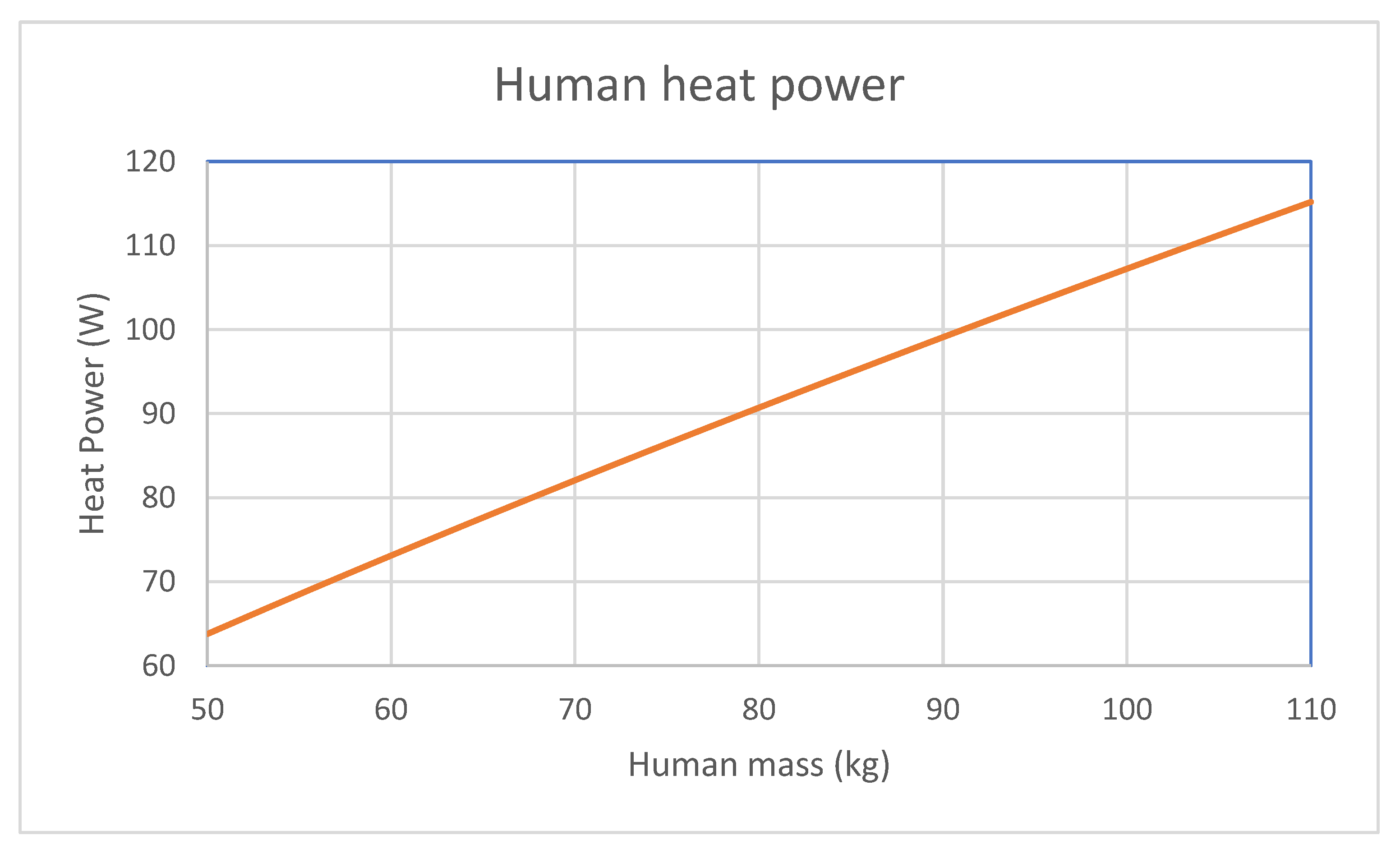

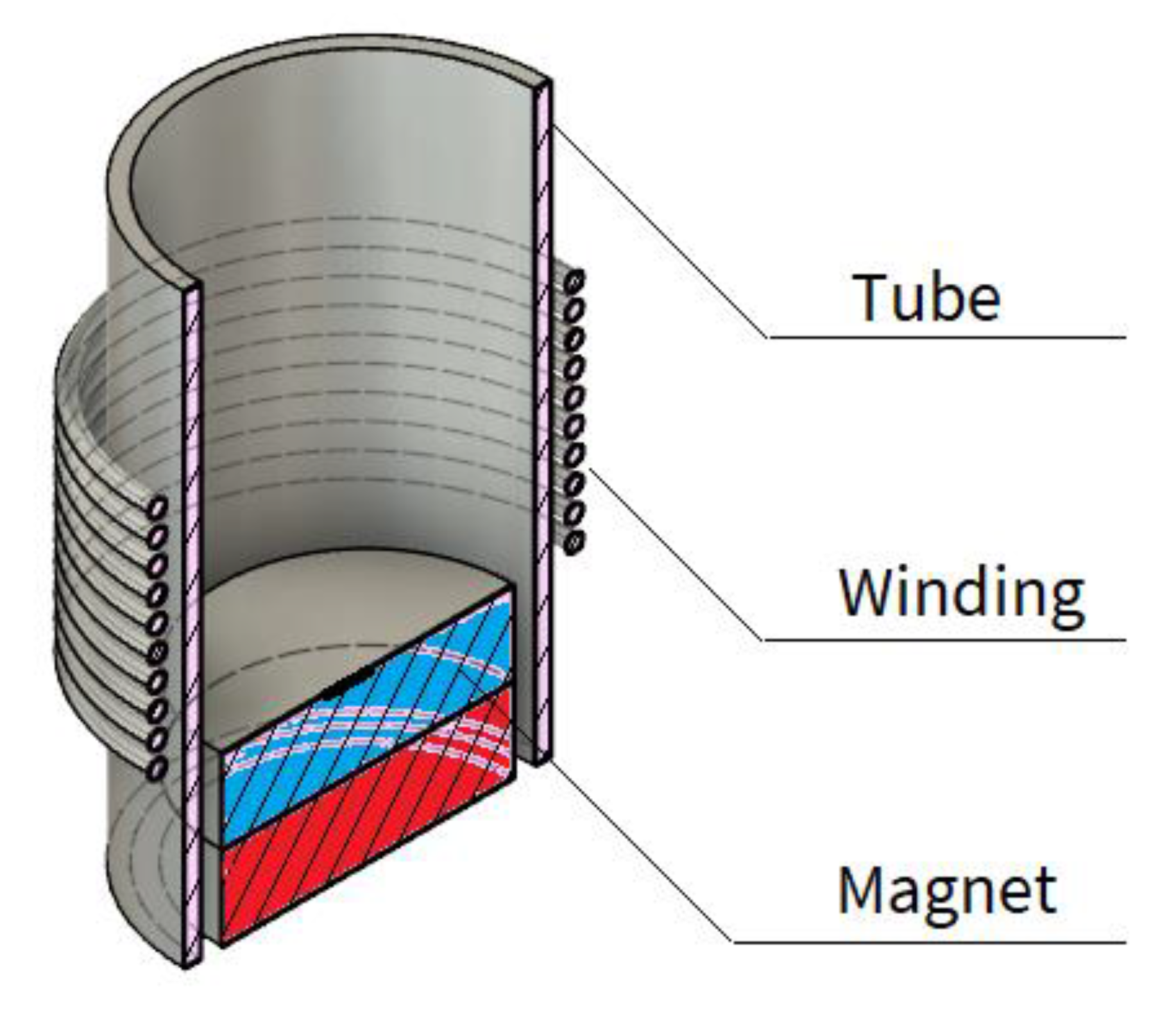
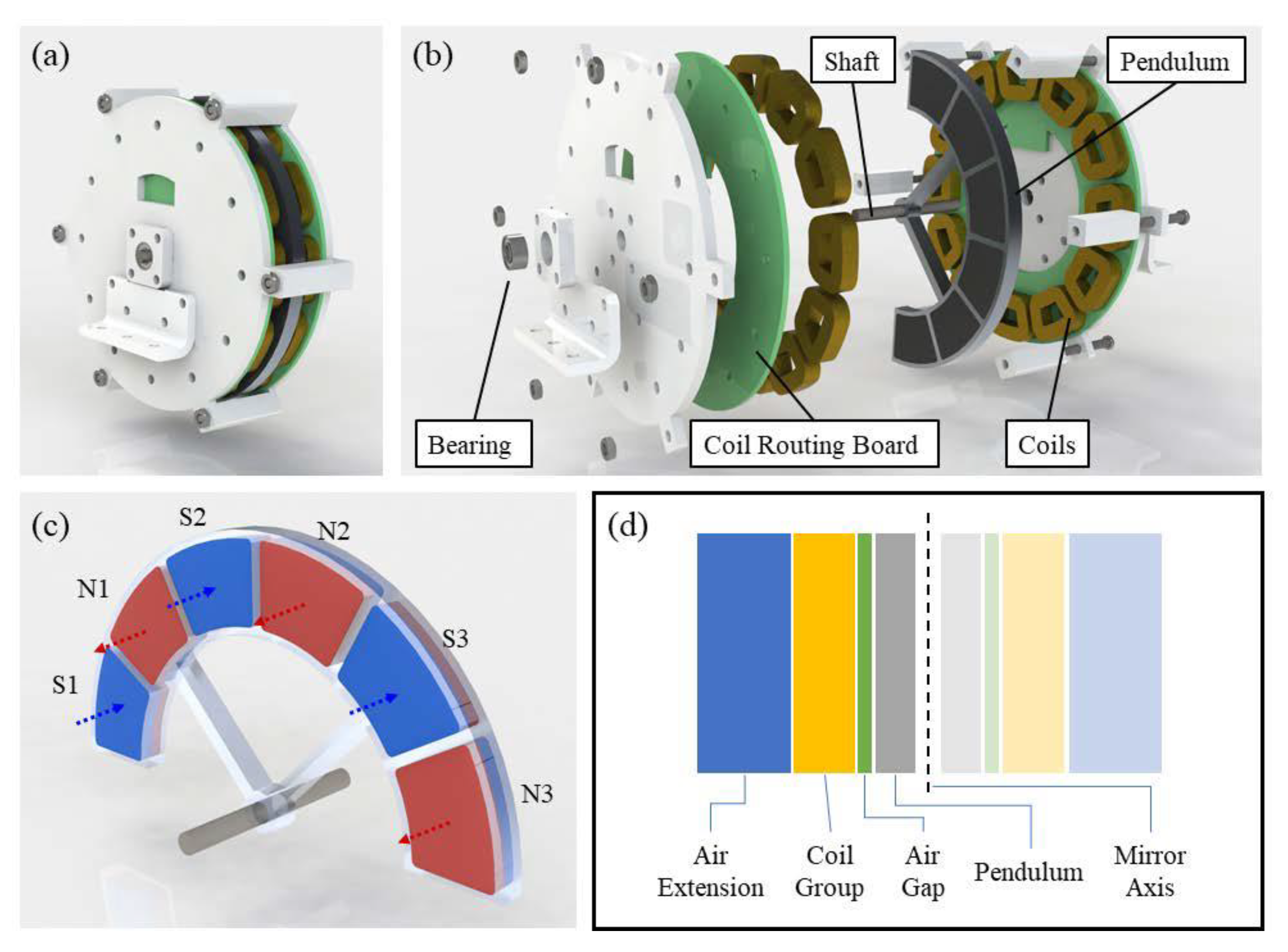

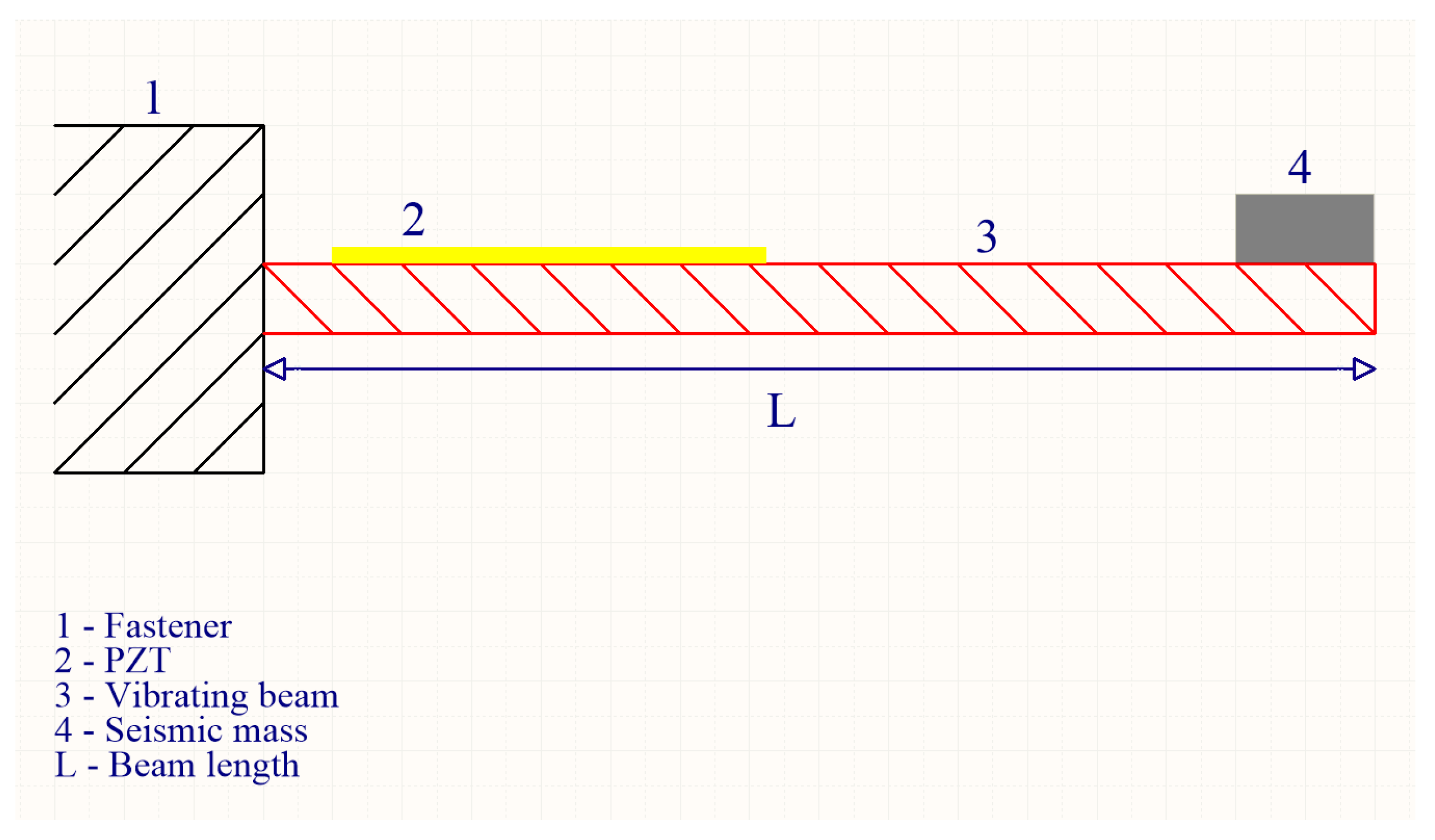

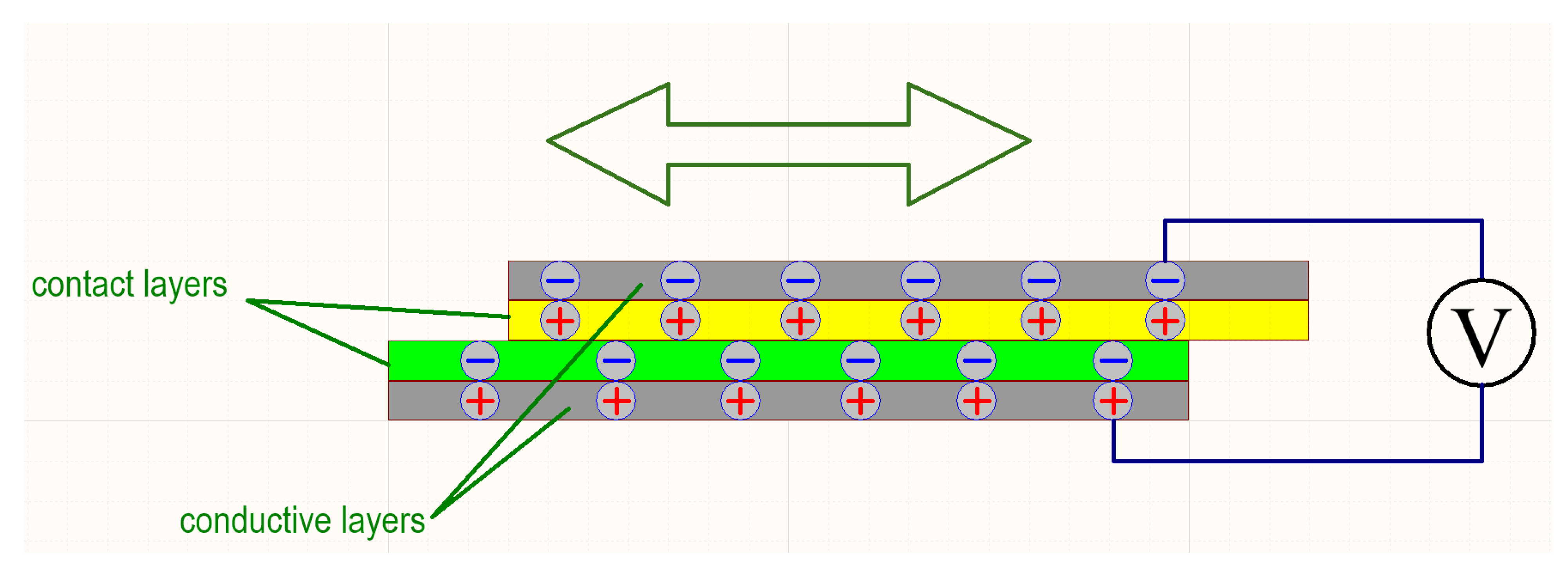
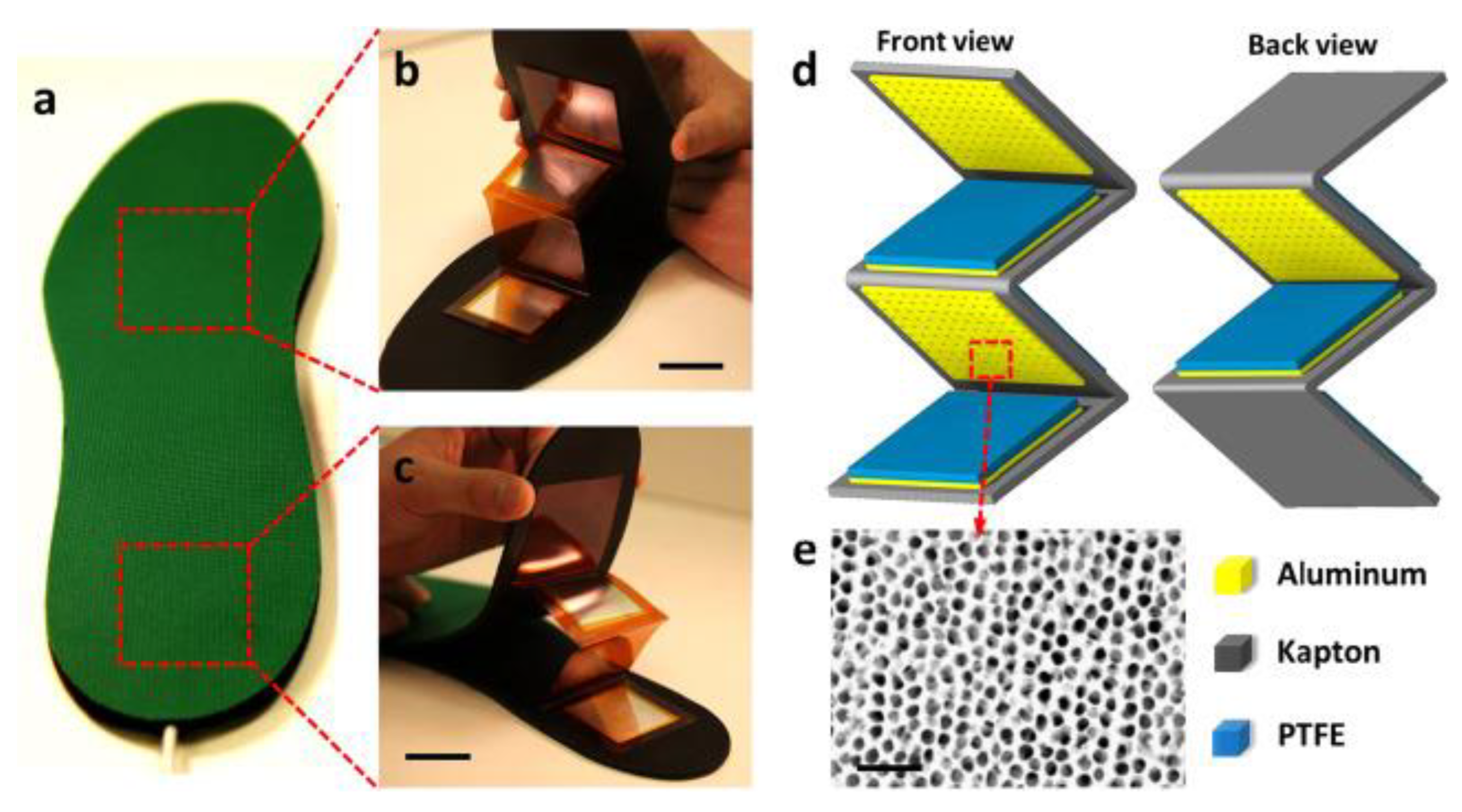



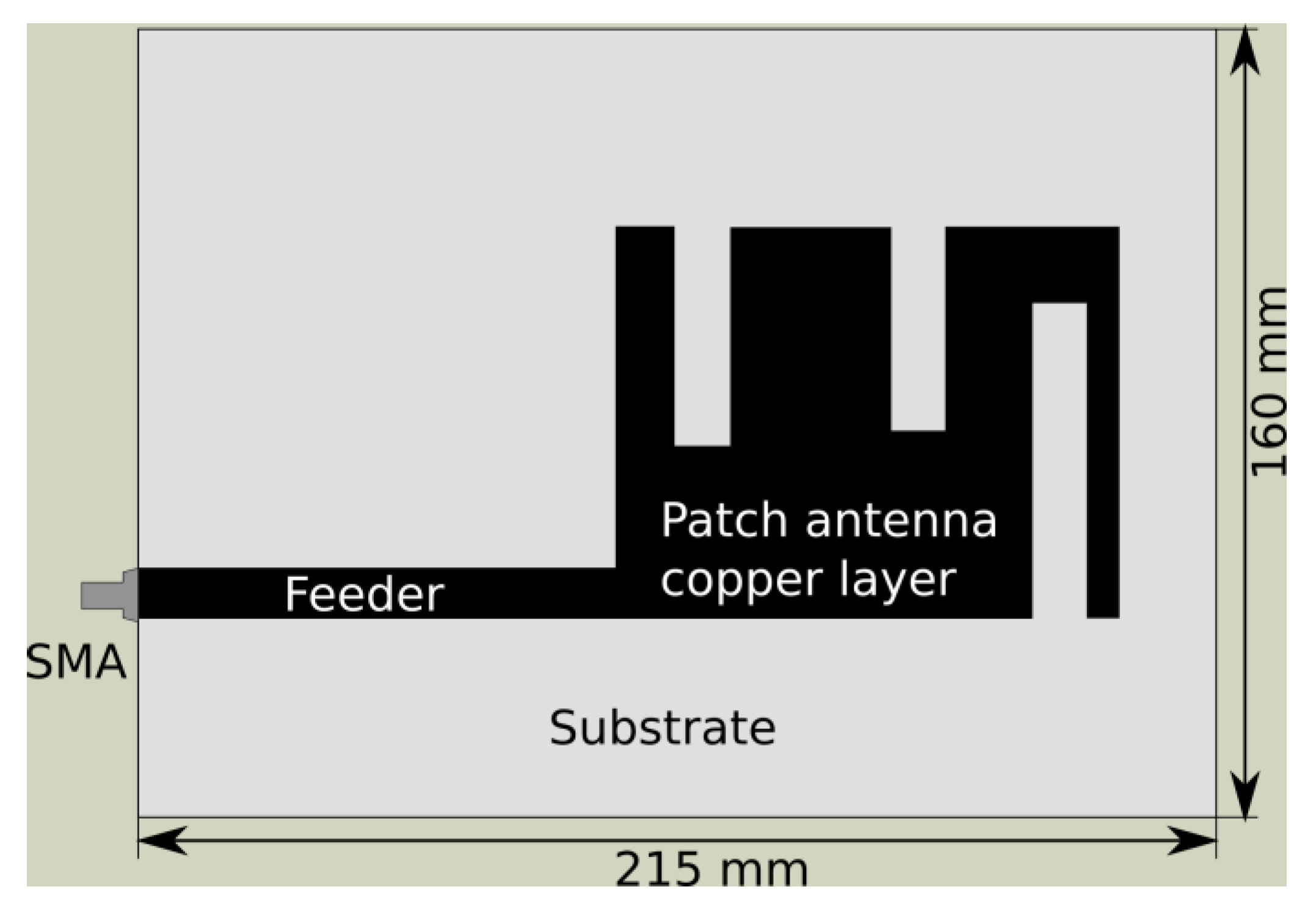
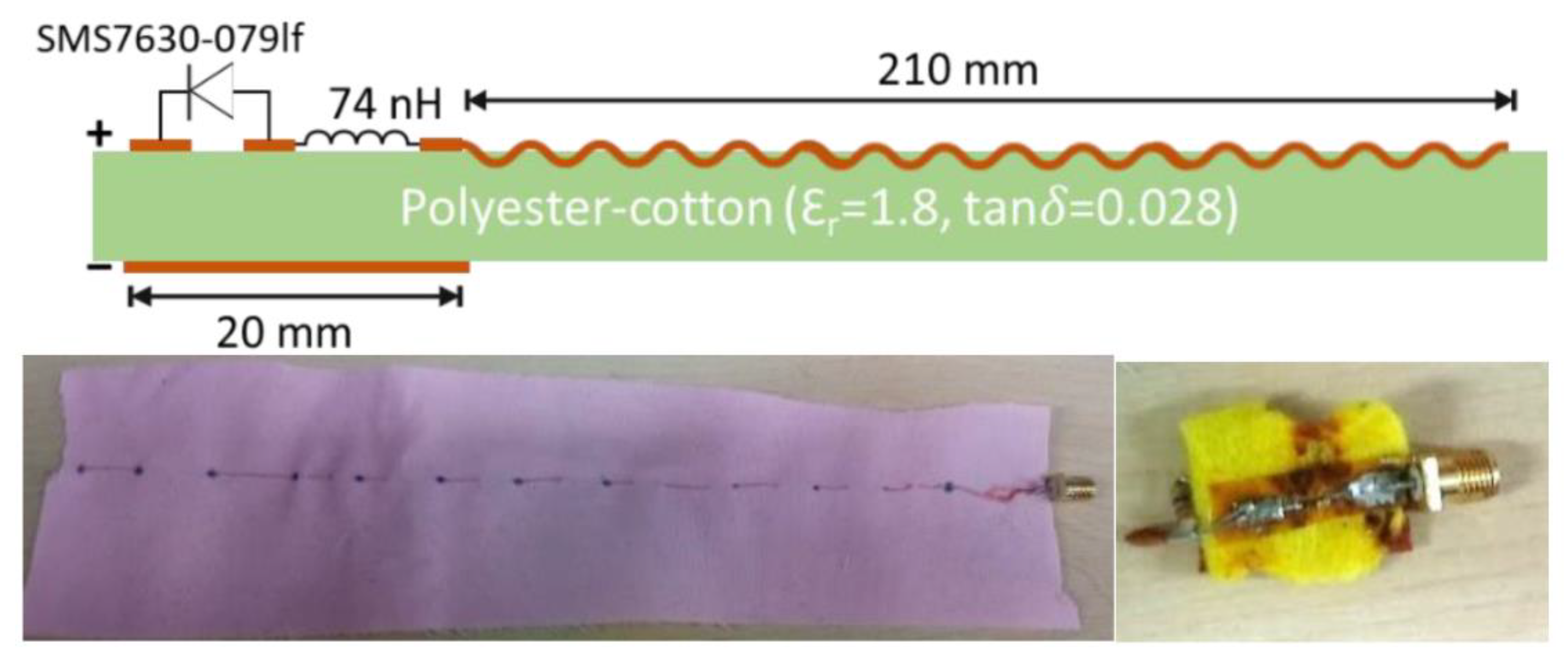
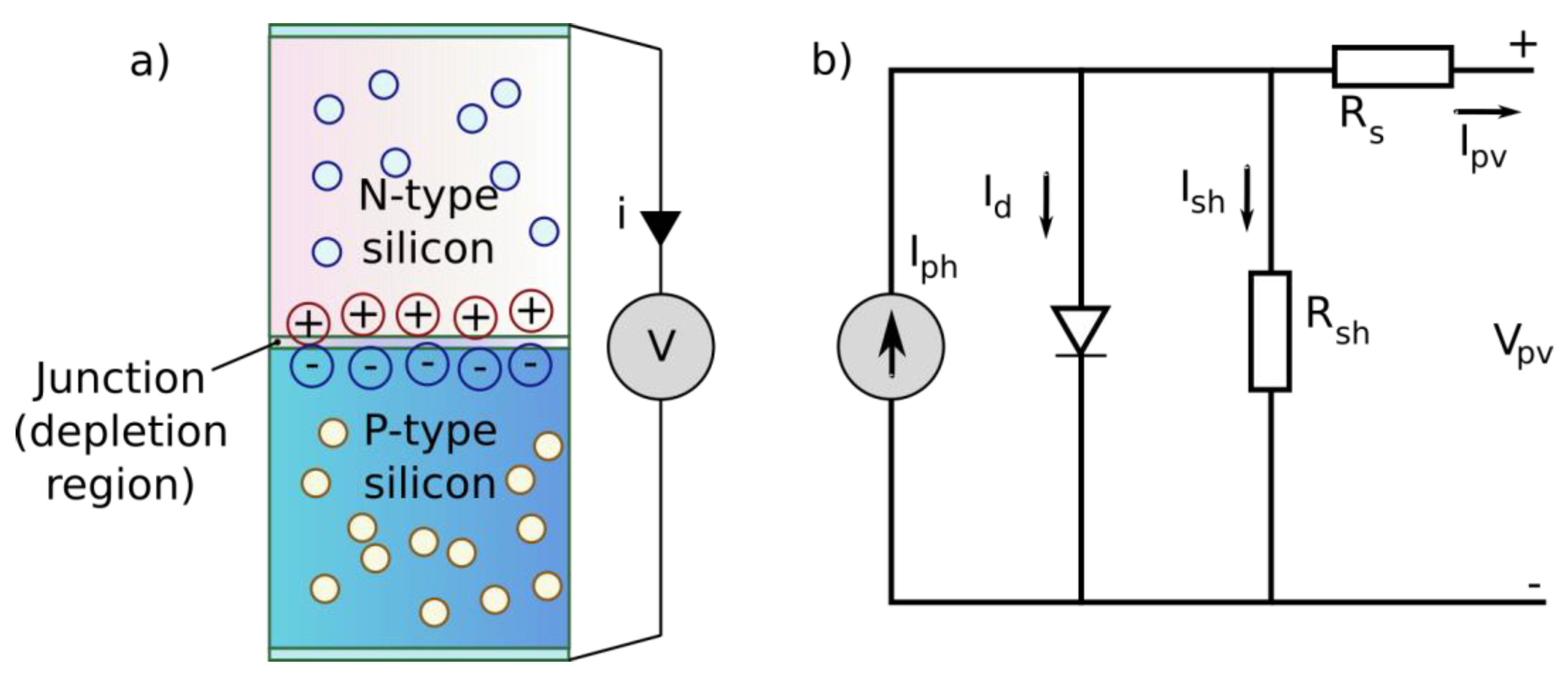
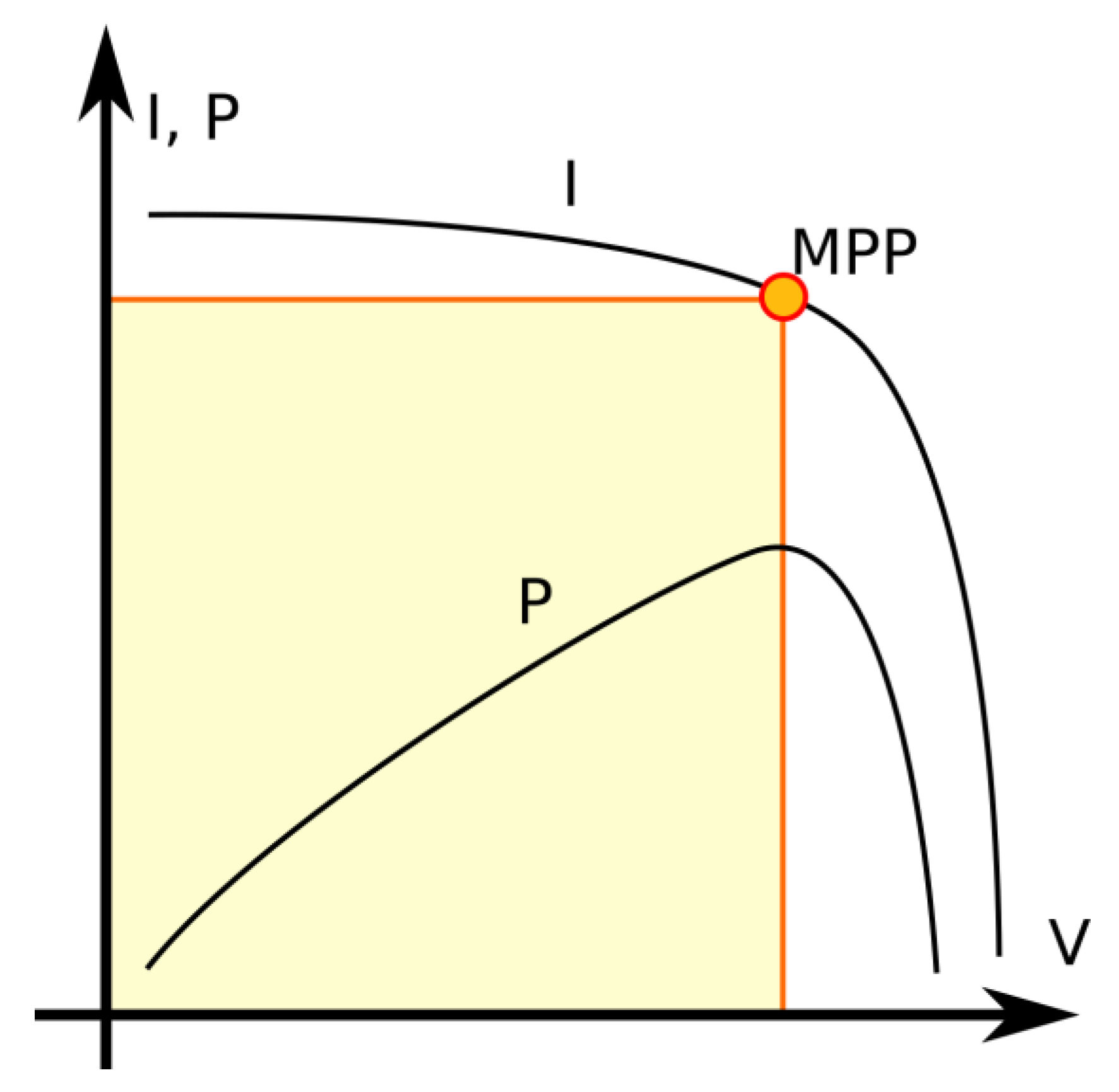
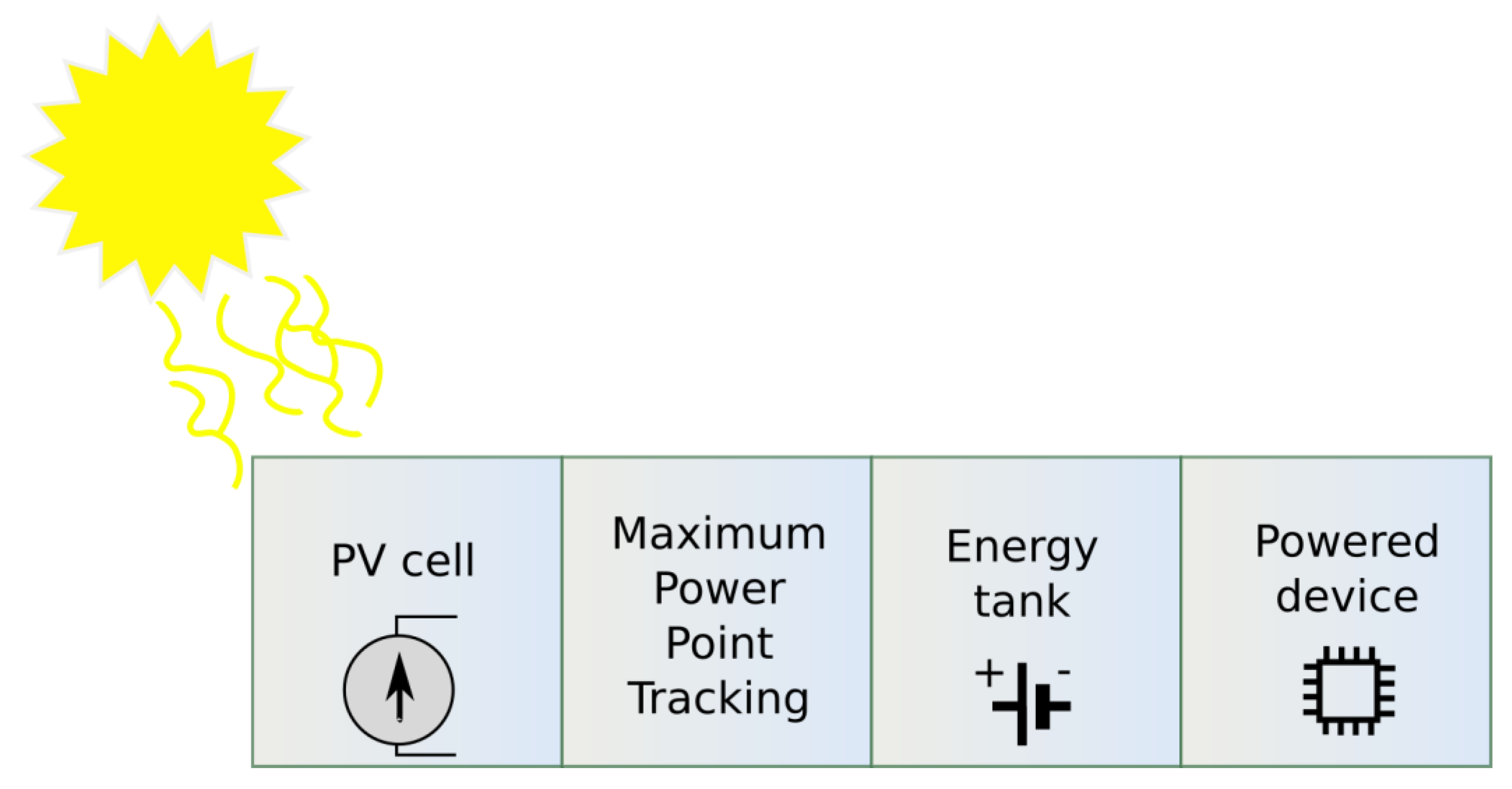
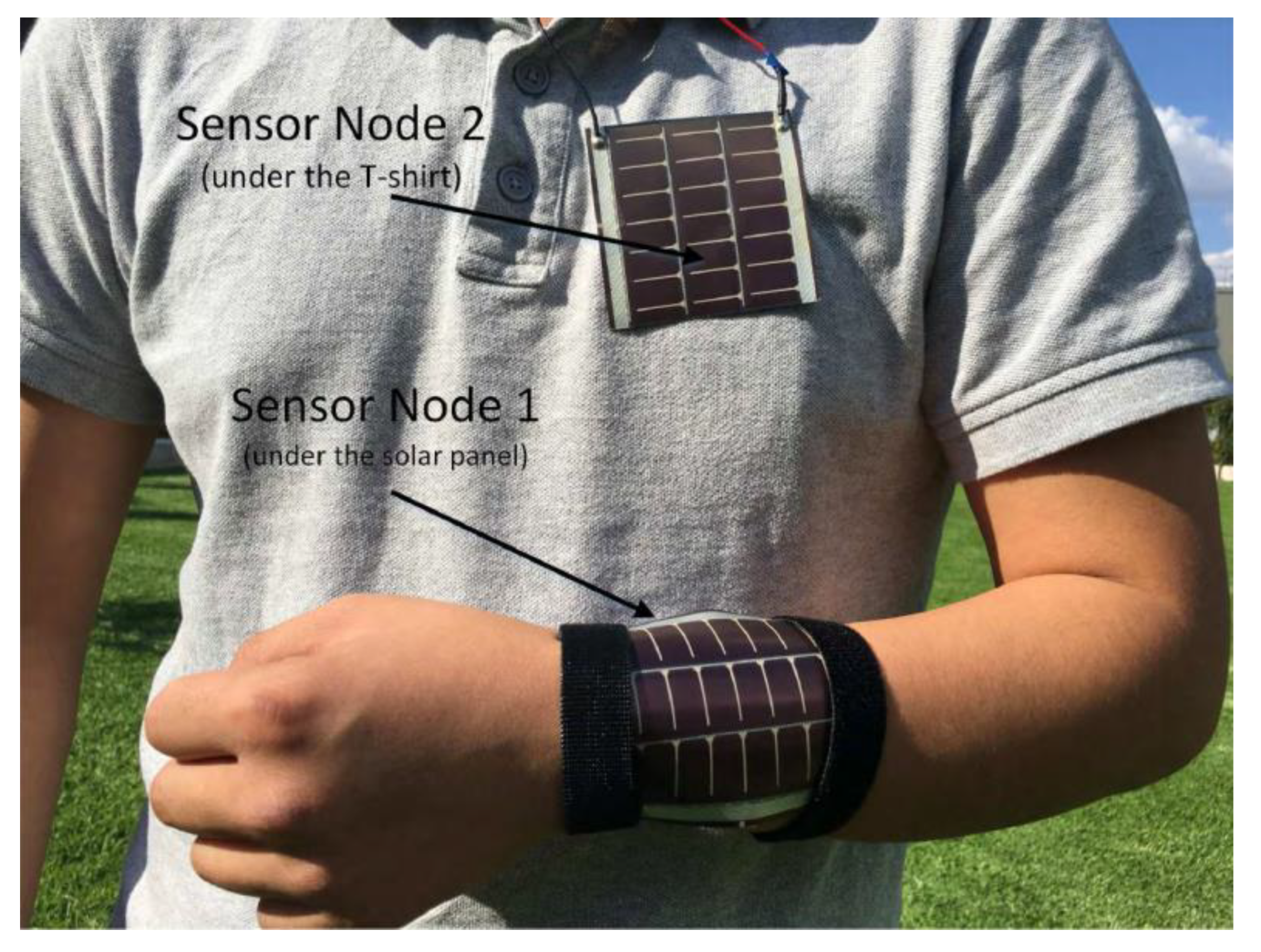
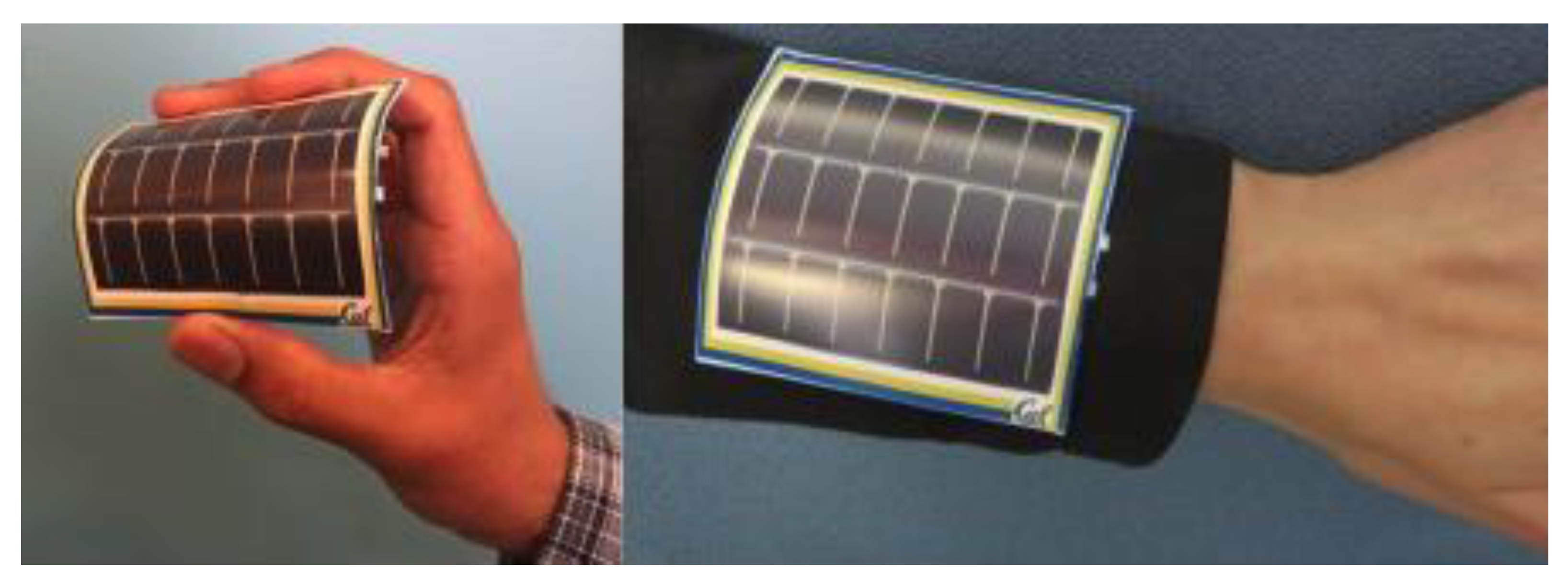
| Process | Office Work | Active Work | ||
|---|---|---|---|---|
| Metabolic energy intake | 12.4 MJ | 100% | 16.1 MJ | 100% |
| Basal metabolism | 7.8 MJ | 63% | 7.8 MJ | 48.4% |
| Food-induced thermogenesis | 1.9 MJ | 15% | 2.4 MJ | 15% |
| Physical activity | 2.7 MJ | ~22% | 5.9 MJ | ~36.6% |
| Activity | Calorific Values [kcal/min] | Metabolic Equivalent of Task [MET] |
|---|---|---|
| Reading | 0.4 | <1 |
| Driving | 0.8 | <1 |
| Walking (3.2 km) | 3.1 | 2.5 |
| Cycling (slow) | 4.4 | 3.5 |
| Swimming (slow) | 5.6 | 4.5 |
| Walking (6.4 km) | 5.6 | 4.5 |
| Playing tennis | 6.3 | 5 |
| Cycling (fast) | 7.1 | 5.7 |
| Sex (female) | 7.0 | 5.6 |
| Sex (male) | 7.5 | 6 |
| Swimming (fast) | 8.8 | 7 |
| Rowing | 13 | 10.6 |
| Running (14 km/h) | 15.9 | 12.7 |
| Running sprint (~30 km/h) | 38.3 | 30.6 |
| Form of Energy | Place of Installation | Electric Power Achievable after Conversion | Type of Harvester |
|---|---|---|---|
| Heat | Skin | 5–18 μW/cm2 | Thermoelectric-generator |
| Heat | Internal tissues | 12 μW/cm3 | Thermoelectric-generator |
| Kinetic | Bending fingers | 1 mW | Piezoelectric |
| Kinetic | The work of hands | 3–100 mW | Piezoelectric Magnetoelectric Triboelectric |
| Kinetic | The work of legs | 1–200 mW | Piezoelectric Magnetoelectric Triboelectric |
| Type | Form | Place of Installation | Vibration | Power | [Ref] |
|---|---|---|---|---|---|
| Linear | Matrix of 16 harvester | Ankle | 2.8 m/s | 14.8 mW | [29] |
| Linear | 1 magnet with ferrofluid/2 coils | Ankle | 2.8 m/s | 9.5 mW | [30] |
| Linear | 4 magnets stack with ferrofluid/3 coils | Ankle | 2.8 m/s | 54.6 mW | [31] |
| Linear | 1 magnet/curved coil | Forearm | 1.8 m/s | 5.8 mW | [32] |
| Linear | 2 magnets/2 coils | - | 10 Hz | 110 mW | [33] |
| Linear | 6 magnets/12 coils | Arm | 1.5–3 Hz | 7.8 mW | [35] |
| Linear | 6 magnets/4 coils | Wrist/Ankle | 3 Hz | 10/200 µW | [36] |
| Linear | 1 magnet/4 coils | Wrist | - | 0.2 mW/cm2 | [37] |
| Rotary | Kinetron microgenerator system | Wrist | 2.5 m/s | 400 µW | [38] |
| Rotary | Kinetron microgenerator system | Wrist/Ankle | 3.6 m/s | 429/620 µW | [39] |
| Flat | Magnet with ferrofluid bearings/coil | Back | 2–4 Hz | 18.1 µW | [40] |
| Rotary | 6 magnets/4 coils | Shoe | 1 Hz | 32 µW | [41] |
| Form | Material | Vibration | Power | [Ref] |
|---|---|---|---|---|
| Piezo-electromagnetic hybrid | PZT | 51 Hz | 269 µW | [45] |
| Flexible beam | PZT | 3 Hz | 5 µW | [46] |
| Flexible beam | PZT-5A | - | 51 µW | [47] |
| Rotating proof mass | - | 2 Hz | 43 µW | [48] |
| Flexible Substrate | PMN-PT | 2 Hz | - | [49] |
| Two-stage mechanism | PZT | 2 Hz | 65.8 mW | [50] |
| Stretched mass | PZT-5H | 1 Hz | 1.43 mW | [44] |
| Form | Material | Vibration | Power | [Ref] |
|---|---|---|---|---|
| Microneedle array | Al, PE, Cu | 2 Hz | 43 µW | [51] |
| Sandwich-structured | BaTiO3/Silicone rubber | 3 Hz | 5.7 W/m2 | [52] |
| Stretchable capacities | MXene/PVA Hydrogel | 1 Hz | 330 µW | [53] |
| Stretchable electrode | NaCL | 5 Hz | 4.61 W/m2 | [54] |
| Stretchable electrode | PWP composite | 2.5 Hz | 2.3 W/m2 | [55] |
| Stretchable single electrode | Organohydrogel | - | 710 mW/m2 | [56] |
| Flexible multi layers | Al, Kapton, PTFE | 1 Hz | 62.5 mW | [57] |
| Form | Material | ΔT | Power | [Ref] |
|---|---|---|---|---|
| Three thermoelectric modules | - | 15 K | 0.7 mW | [58] |
| Composite foil | PVDF/Bi2Te3 | 25 K | 12.6 nW | [59] |
| Flexible printed circuit board | Bi2Te3 | 12 K | 130.6 nW | [60] |
| TES1-12704 module | Bi2Te3 | 12 K | 50 µW | [61] |
| Composite thermoelectric fabric | CNT/PVP/PU | 12 K | 5.14 μWm−1K−2 | [62] |
| Flexible printed circuit board | Bi2Te3 | 50 K | 192.6 µW | [63] |
| Description | RF Input | Efficiency | Voltage Output | Dimensions | [Ref] |
|---|---|---|---|---|---|
| RF Kick-start for TEG | ISM: 433 MHz at –10 dBm | - | >0.6 V | - | [67] |
| Multi-band slot-ring antenna | 900 MHz, 1.575 GHz, 2.025 GHz, 2.36 GHz | - | 0.65 V | 66 mm × 70 mm | [68] |
| Dielectric resonator rectenna | 2.45 GHz | Up to 60% | 2.3 V | 30 mm × 30 mm × 10 mm | [71] |
| Textile rectenna for biomedical device | 2.45 GHz | Up to 17% | 2.1 V at 0 dBm 11 V at 2 × 2 patch | 50 mm × 42 mm PCB 90 mm × 100 mm antenna | [70] |
| Rectenna | 5.8 GHz | 75% 40% at 16 dBm | 3 V at 12 dBm | 85 mm × 85 mm | [72] |
| Dual-band: simultaneous EH and communication | 785–875 MHz (EH) 2.4 GHz (comm.) | 62% from 0.8 μW/cm2 | 330 mVDC to start boost; over 3.5 V at 0 dBm output | 75 mm × 65 × 3.2 mm (ant.) 3.4 mm × 8.5 mm (rectif.) | [76] |
| Stretchable lattice of wire arches; BAN sensor | 2.4 GHz | - | 1.8 V from supercap. | - | [77] |
| Description | Key Electrical Parameters | Dimensions | [Ref] |
|---|---|---|---|
| Ultrathin sensor for glaucoma diagnosis | 7.7 µW power consumption in active state 550 pW in idle state 5 years of operation without recharging, 49 years of operation with recharging | 8.75 mm3 | [78] |
| Flexible, wearable PV with body parameters sensors and BLE connectivity | Harvesting 140 mW at 3.75 V in “high-irradiance” conditions 12.5 F supercapacitor Up to 60 mA provided current | 7.2 cm × 6 cm PV panel | [79] |
| Flexible PCB and PV panel | 600 µW at 1.7 V, 1000 lux | - | [80] |
| Flexible PCB, PV panel, and battery capable of pulsoximetric measurements | 50 mAh flexible, thin battery From 4.1 V to 3.6 V during discharge Operational for 120 min without recharging | - | [81] |
| Flexible bracelet with BLE connectivity | 40 mAh rigid battery, 3.3 V Energy harvesting: 0.15 mW @ 500 lux, 16.5 mW at 10,000 lux Perpetual work @ 1000 lux | - | [82] |
| Small, ink-based OPV cell on glass substrate | Very small organic PV cell providing 1.2 mW at 0.5 V at 110,000 lux (bright day) After voltage doubling: 1.2 V, 0.11 mA | 12 mm × 12 mm PV | [84] |
| Harvester Type | Power Density—Performance | Durability | Cost | Ref. |
|---|---|---|---|---|
| Piezoelectric | up to 10.55 mW/cm3 | Middle | Middle | [50] |
| Electromagnetic | up to 3.4 mW/cm2 | Middle/low | Low | [29,33] |
| Flexible PV panel | up to 3.2 mW/cm2 | Middle | Low | [79] |
| Triboelectric | up to 0.6 mW/cm2 | Middle/low | Middle | [52] |
| RF Harvester | up to 0.2 mW/cm2 | High | Low | [72] |
| Thermoelectric | up to 0.02 mW/cm2 | High | Low | [63] |
Disclaimer/Publisher’s Note: The statements, opinions and data contained in all publications are solely those of the individual author(s) and contributor(s) and not of MDPI and/or the editor(s). MDPI and/or the editor(s) disclaim responsibility for any injury to people or property resulting from any ideas, methods, instructions or products referred to in the content. |
© 2023 by the authors. Licensee MDPI, Basel, Switzerland. This article is an open access article distributed under the terms and conditions of the Creative Commons Attribution (CC BY) license (https://creativecommons.org/licenses/by/4.0/).
Share and Cite
Dziadak, B.; Makowski, Ł.; Kucharek, M.; Jóśko, A. Energy Harvesting for Wearable Sensors and Body Area Network Nodes. Energies 2023, 16, 1681. https://doi.org/10.3390/en16041681
Dziadak B, Makowski Ł, Kucharek M, Jóśko A. Energy Harvesting for Wearable Sensors and Body Area Network Nodes. Energies. 2023; 16(4):1681. https://doi.org/10.3390/en16041681
Chicago/Turabian StyleDziadak, Bogdan, Łukasz Makowski, Mariusz Kucharek, and Adam Jóśko. 2023. "Energy Harvesting for Wearable Sensors and Body Area Network Nodes" Energies 16, no. 4: 1681. https://doi.org/10.3390/en16041681
APA StyleDziadak, B., Makowski, Ł., Kucharek, M., & Jóśko, A. (2023). Energy Harvesting for Wearable Sensors and Body Area Network Nodes. Energies, 16(4), 1681. https://doi.org/10.3390/en16041681








